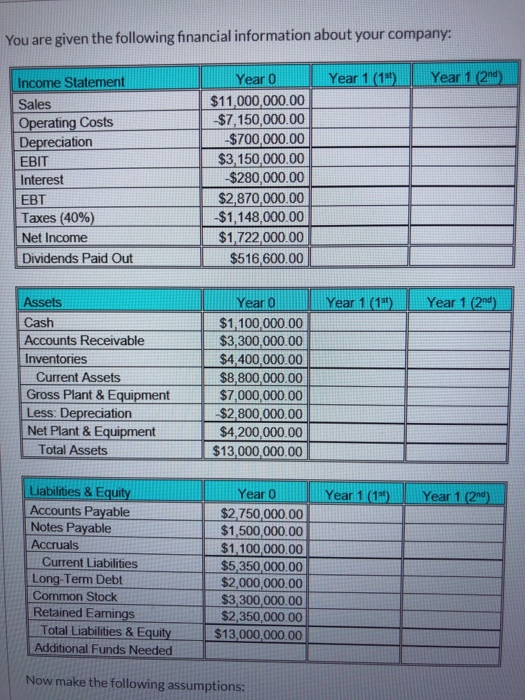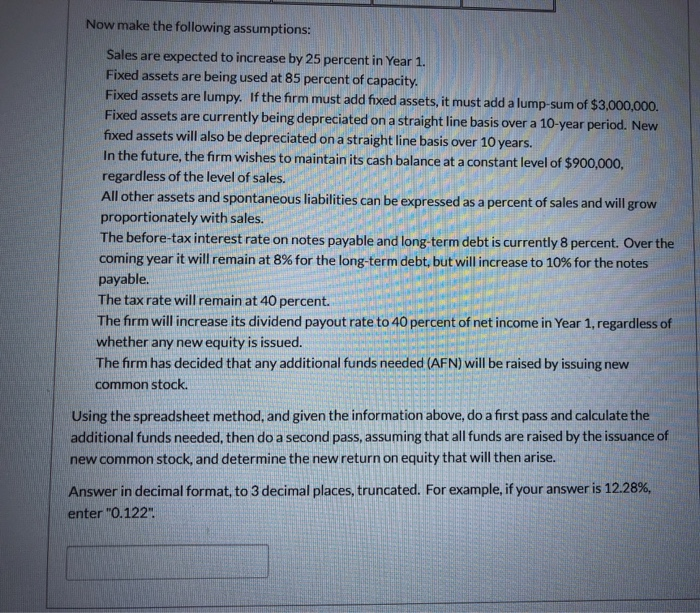You are given the following financial information about your company: Year 1 (1 Year 1 (Onay Income Statement Sales Operating costs Depreciation EBIT Interest EBT Taxes (40%) Net Income Dividends Paid Out Year 0 $11,000,000.00 $7,150,000.00 -$700,000.00 $3,150,000.00 $280,000.00 $2,870,000.00 $1,148,000.00 $1,722,000.00 $516,600.00 Year 1 (11) Year 1 (2nd) Assets Cash Accounts Receivable Inventories Current Assets Gross Plant & Equipment Less: Depreciation Net Plant & Equipment Total Assets Year 0 $1,100,000.00 $3,300,000.00 $4,400,000.00 $8,800,000.00 $7,000,000.00 $2,800,000.00 $4,200,000.00 $13,000,000.00 Year 1 (1:35) Year 1 (20) Liabilities & Equity Accounts Payable Notes Payable Accruals Current Liabilities Long-Term Debt Common Stock Retained Earnings Total Liabilities & Equity Additional Funds Needed Year 0 $2,750,000.00 $1,500,000.00 $1,100,000.00 $5,350,000.00 $2,000,000.00 $3,300,000.00 $2,350,000.00 $13,000,000.00 Now make the following assumptions: Now make the following assumptions: Sales are expected to increase by 25 percent in Year 1. Fixed assets are being used at 85 percent of capacity. Fixed assets are lumpy. If the firm must add fixed assets, it must add a lump sum of $3,000,000. Fixed assets are currently being depreciated on a straight line basis over a 10-year period. New fixed assets will also be depreciated on a straight line basis over 10 years. In the future, the firm wishes to maintain its cash balance at a constant level of $900,000, regardless of the level of sales. All other assets and spontaneous liabilities can be expressed as a percent of sales and will grow proportionately with sales. The before-tax interest rate on notes payable and long-term debt is currently 8 percent. Over the coming year it will remain at 8% for the long-term debt, but will increase to 10% for the notes payable. The tax rate will remain at 40 percent. The firm will increase its dividend payout rate to 40 percent of net income in Year 1. regardless of whether any new equity is issued. The firm has decided that any additional funds needed (AFN) will be raised by issuing new common stock. Using the spreadsheet method, and given the information above, do a first pass and calculate the additional funds needed, then do a second pass, assuming that all funds are raised by the issuance of new common stock, and determine the new return on equity that will then arise. Answer in decimal format, to 3 decimal places, truncated. For example, if your answer is 12.28%, enter "0.122 You are given the following financial information about your company: Year 1 (1 Year 1 (Onay Income Statement Sales Operating costs Depreciation EBIT Interest EBT Taxes (40%) Net Income Dividends Paid Out Year 0 $11,000,000.00 $7,150,000.00 -$700,000.00 $3,150,000.00 $280,000.00 $2,870,000.00 $1,148,000.00 $1,722,000.00 $516,600.00 Year 1 (11) Year 1 (2nd) Assets Cash Accounts Receivable Inventories Current Assets Gross Plant & Equipment Less: Depreciation Net Plant & Equipment Total Assets Year 0 $1,100,000.00 $3,300,000.00 $4,400,000.00 $8,800,000.00 $7,000,000.00 $2,800,000.00 $4,200,000.00 $13,000,000.00 Year 1 (1:35) Year 1 (20) Liabilities & Equity Accounts Payable Notes Payable Accruals Current Liabilities Long-Term Debt Common Stock Retained Earnings Total Liabilities & Equity Additional Funds Needed Year 0 $2,750,000.00 $1,500,000.00 $1,100,000.00 $5,350,000.00 $2,000,000.00 $3,300,000.00 $2,350,000.00 $13,000,000.00 Now make the following assumptions: Now make the following assumptions: Sales are expected to increase by 25 percent in Year 1. Fixed assets are being used at 85 percent of capacity. Fixed assets are lumpy. If the firm must add fixed assets, it must add a lump sum of $3,000,000. Fixed assets are currently being depreciated on a straight line basis over a 10-year period. New fixed assets will also be depreciated on a straight line basis over 10 years. In the future, the firm wishes to maintain its cash balance at a constant level of $900,000, regardless of the level of sales. All other assets and spontaneous liabilities can be expressed as a percent of sales and will grow proportionately with sales. The before-tax interest rate on notes payable and long-term debt is currently 8 percent. Over the coming year it will remain at 8% for the long-term debt, but will increase to 10% for the notes payable. The tax rate will remain at 40 percent. The firm will increase its dividend payout rate to 40 percent of net income in Year 1. regardless of whether any new equity is issued. The firm has decided that any additional funds needed (AFN) will be raised by issuing new common stock. Using the spreadsheet method, and given the information above, do a first pass and calculate the additional funds needed, then do a second pass, assuming that all funds are raised by the issuance of new common stock, and determine the new return on equity that will then arise. Answer in decimal format, to 3 decimal places, truncated. For example, if your answer is 12.28%, enter "0.122








